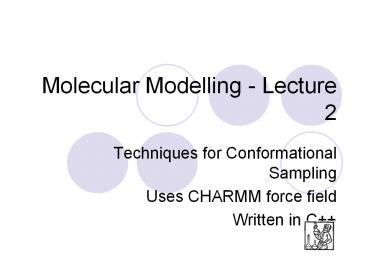Molecular Modelling - Lecture 2 - PowerPoint PPT Presentation
1 / 24
Title:
Molecular Modelling - Lecture 2
Description:
Molecular Modelling - Lecture 2 Techniques for Conformational Sampling Uses CHARMM force field Written in C++ – PowerPoint PPT presentation
Number of Views:302
Avg rating:3.0/5.0
Title: Molecular Modelling - Lecture 2
1
Molecular Modelling - Lecture 2
- Techniques for Conformational Sampling
- Uses CHARMM force field
- Written in C
2
Protein example
3
Monte Carlo Simulations
- Technique used to perform first computer
simulation of a molecular system - Monte Carlo some kind of random sampling
4
Monte Carlo Methods
- Basis of Monte Carlo methods is the use of random
selections in calculations that lead to the
solution of numerical and physical problems e.g. - brownian motion
- molecular modelling
- designing nuclear reactors
- predicting the evolution of stars
- forecasting the stock market
- Each calculation is independent of the others and
hence amenable to embarrassingly parallel methods
5
Monte Carlo Integration finding value of p
- Monte Carlo integration
- Compute r by generating random points in a square
of side 2 and counting how many of them are in
the circle with radius 1 (x2y2lt1 p4ratio) .
Area of square4
Area p
2
2
6
Monte Carlo Simulations
- Configurations are generated by making random
changes to the positions of the atoms - Importance sampling
- Samples from 3N dimensional space of positions of
molecules
7
Monte Carlo Simulations
Z Configurational integral
8
Metropolis Monte Carlo
- Biases generation of configurations towards those
that make the most significant contributions to
the integral - Low energy states for most thermodynamic
properties - Generates states with probability exp(?????x??and
counts them equally - (simple Monte Carlo would generate them with
equal probability and then weight them by
exp(?????x? ?
9
Markov chain of states
10
Monte Carlo Advantages/Disadvantages
- Advantages
- Does not require a continuous energy function (as
in MD) - Number of particles can easily vary (very hard in
MD) - Disadvantages
- Highly correlated motions hard to simulate
- Poor sampling of large-scale changes
11
Molecular Dynamics
- Newtons equations of motions are integrated to
propagate the structure through time
12
Molecular Dynamics
- fast large systems can be modelled
- history of molecular motion and interactions
- conformational distribution for simulation
?
13
Molecular Dynamics - Integration methods
- Finite difference methods
- Used to generate molecular dynamics trajectories
with continuous potentials - Integration broken into stages separated by time
?t - Total force on each particle at time t is
calculated as a vector sum of all the
interactions with other particles - From force can determine accelerations
- Combined with positions and velocities at time t
to calculate positions and velocities at time t
?t - Force assumed to be constant during time step
14
Molecular Dynamics - Integration methods
- Many algorithms
- Verlet
- Leap frog method
- Predictor-corrector
- Velocity-Verlet
15
Molecular Dynamics - Verlet Integration Method
- Most widely used method
16
Timescale Limitations
17
MD Production Run Protocol
Initial coords obtained from experimental data or
theoretical model
Can be done by randomly selecting from a
Maxwell-Boltzmann distribution at the temperature
of interest
18
(No Transcript)
19
(No Transcript)
20
(No Transcript)
21
Truncating Long-Range forces and the minimum
image convention
- Non-bonded interactions most time-consuming part
of a simulation - N2
- Minimum image convention
- Interaction for a molecule i are only counted
between it and its closest image - Truncation of potential creates problems with
consistent potential and force
22
Truncating Long-Range forces and the minimum
image convention
- Use smoothing functions to smoothly switch off
the interaction between a cut-on and a
cut-off distance.
23
(No Transcript)
24
Simulated Annealing
- special case of either MD (quenched' MD) or MC
simulation, in which the temperature is gradually
reduced during the simulation. - Often, the system is first heated and then cooled
- the system is given the opportunity to surmount
energetic barriers in a search for conformations
with energies lower than the local-minimum energy
found by energy minimization. - can lead to more realistic simulations of
dynamics at low temperature - more expensive than energy minimization.































